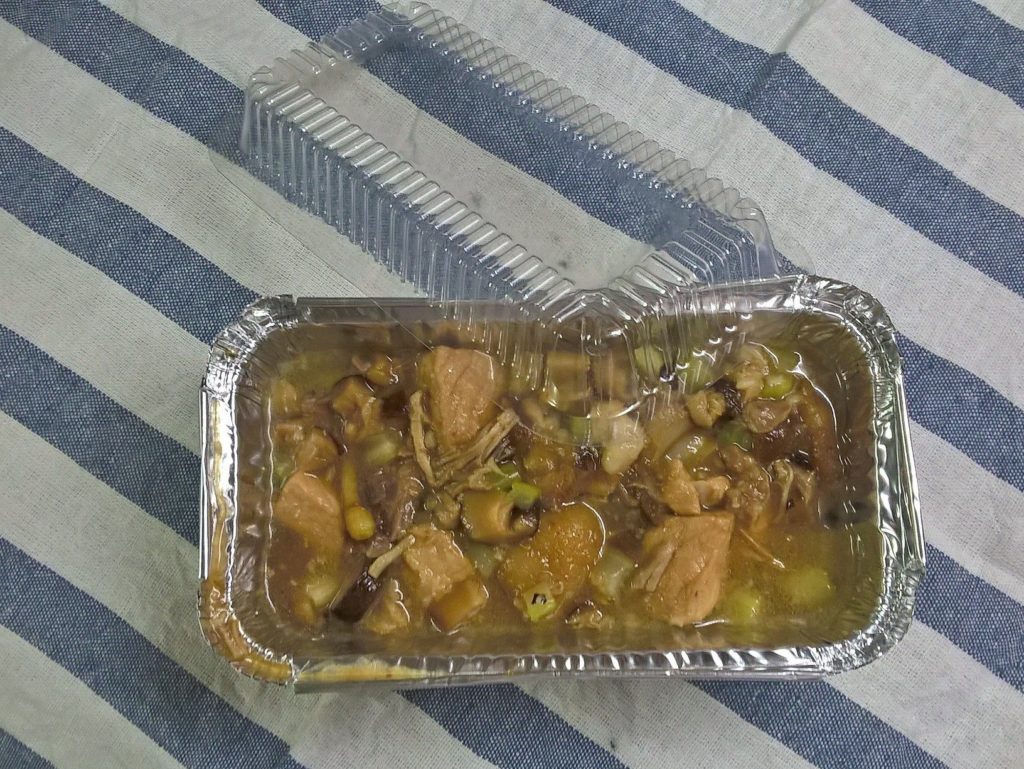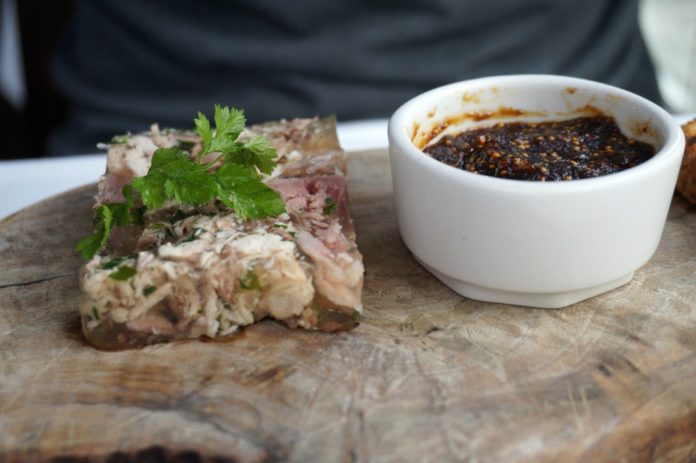| ผู้เขียน | Danai Huntrakul |
|---|---|
| เผยแพร่ |
“หมูตั้ง คืออะไรคะ คุณแม่” เสียงลูกสาว แว่วมาจากริมสวน
“แม่ก็ไม่รู้เหมือนกัน ไปถามพี่แดงสิ” คุณแม่ตอบจากหน้าจอโทรทัศน์ มือง่วนกับการถักไหมพรมเป็นชุดให้เจ้า “จูลี่” ตุ๊กตาผ้าหน้าตาขี้เหร่กัวล่าจากออสเตรเลียของพี่แดง
เรามาถึงตรงนี้ได้อย่างไร
หมูตั้ง เป็นอาหารจีน “ตือเถาจั่ง” ต้นกำเนิดที่เมืองเถ่งไฮ่ ประเทศจีน เขานำหัวหมูพะโล้มาเลาะมัน หั่นชิ้นเล็ก อัดลงในพิมพ์สี่เหลี่ยมบุฟองเต้าหู้ ทับด้วยของหนักให้น้ำมันและน้ำพะโล้ซึมออกมา เมื่อได้ที่จะติดกันเป็นแท่งหนา นำมาหั่นเป็นแว่นหนา กินกับข้าวต้ม ซีอิ๊วขาว ไม่ปรุงรสอะไร
ในเมืองเทียนสิน ทางเหนือ เขตต่อกับปักกิ่ง เรียก “เยาโญ่ว” ใช้ขาหมูตุ๋นเลาะกระดูก เอามาม้วนอัดเป็นแท่ง กินกับซีอิ๊วเจือน้ำส้มผสมกระเทียมกับพริกแดงสดบด ที่เกาหลีก็ทำแบบเดียวกัน
ส่วนในเวียดนาม ใช้เนื้อจากหัวหูหมู สามชั้น ปรุงกระเทียม ต้นหอม หอมใหญ่ เห็ดหูหนู พริกไทย น้ำปลา ห่อใบตอง อัดเข้าพิมพ์ไม้ กินในเทศกาลตรุษญวน ซึ่งตรงกับตรุษจีน
เมื่อมาถึงเมืองไทย หมูตั้ง รสหวานเค็ม สีออกดำ น้ำจิ้ม พริกชี้ฟ้า กระเทียม น้ำส้มสายชู กินกับแตงกวา หรือที่หั่นเป็นเส้น ใส่ไส้เปาะเปี๊ยะสด
 จานไทยที่ใกล้เคียงหมูตั้ง อยู่ที่ภาคเหนือ ทำจากเนื้อหมู ขาหมูทั้งกีบ ซึ่งมีเจลาติน วุ้นธรรมชาติ ส่วนน้ำแกง ได้จากที่ต้มหมูพร้อมข่า ตะไคร้ ใบมะกรูด หอมแดง พริกขี้หนูแห้ง ต้นหอม ใส่ชามแกงรองด้วยใบผักชี ทิ้งข้ามคืนอากาศเย็น แกงจะแข็งตัว จึงเรียก “แกงกระด้าง” แต่ก่อน ทำกินเฉพาะหน้าหนาว เดี๋ยวนี้ทำกินได้ทุกฤดูกาล โดยเก็บในตู้เย็นช่องปกติ ข้ามคืน ขึ้นโต๊ะได้เลย
จานไทยที่ใกล้เคียงหมูตั้ง อยู่ที่ภาคเหนือ ทำจากเนื้อหมู ขาหมูทั้งกีบ ซึ่งมีเจลาติน วุ้นธรรมชาติ ส่วนน้ำแกง ได้จากที่ต้มหมูพร้อมข่า ตะไคร้ ใบมะกรูด หอมแดง พริกขี้หนูแห้ง ต้นหอม ใส่ชามแกงรองด้วยใบผักชี ทิ้งข้ามคืนอากาศเย็น แกงจะแข็งตัว จึงเรียก “แกงกระด้าง” แต่ก่อน ทำกินเฉพาะหน้าหนาว เดี๋ยวนี้ทำกินได้ทุกฤดูกาล โดยเก็บในตู้เย็นช่องปกติ ข้ามคืน ขึ้นโต๊ะได้เลย
หมูตั้งฝรั่งเข้าข่ายกับแกล้มกินเล่น นิยมกันที่ยุโรป เช่น โครเอเชีย โปแลนด์ โรมาเนีย สโลวะเกีย ฮังการี รัสเซีย เบลารุส และยูเครน โดยเฉพาะในเทศกาลคริสตสมภพ ถือเป็นอาหารชาวบ้าน เมื่อล้มหมูหน้าหนาว เอาเนื้อส่วนอื่นไปหมดแล้ว ก็เอาเศษเนื้อที่แล่ หัวหมู ขาท่อนกีบ ต้มปรุงกับ หอมใหญ่ พริกไทย ออลสไปซ์ (Allspice จากแถบจาเมกา ผลใหญ่กว่าเม็ดพริกไทยสองเท่า กลิ่นและรสชาติคล้ายเครื่องเทศหลายชนิดรวมกัน เผ็ดเหมือนกานพลู ซ่าหวานเหมือนอบเชย หอมเหมือนลูกจันทน์ อบเชย และกานพลูรวมกัน) ใบกระวาน เกลือ และน้ำส้มสายชู ตำรับเก่ามีมาแต่ยุคกลาง สมัยใหม่เข้าเครื่องจีน อย่าง กระเทียม ต้นหอม เก๋ากี้ ขิง และอบเชย วิธีทำก็คล้ายคลึงกัน
 หมูตั้งตำราบางจากบ้านผม ใช้ขาหมูทั้งเนื้อและส่วนกีบ เข้าหม้อความดัน ใส่น้ำพอท่วมล้นหมู เติมขิง พริกไทย เกลือเม็ด ตั้งไว้สิบห้านาที เนื้อยังไม่ทันยุ่ยเละ ดับไฟ ช้อนขึ้นมาเลาะกระดูก ที่ลำบากหน่อยก็ตรงคากิ เพราะกระดูกชิ้นเล็กชิ้นน้อย ต้องค่อยๆ ใช้นิ้วเลาะ ร้อนก็ทนเอา ใส่เนื้อหนังเอ็นกลับเข้าหม้ออัด ทีนี้ก็เติมเครื่องปรุง หอมใหญ่ พุทราจีน กระเทียม รากผักชี โป๊ยกั้ก และอบเชย ปิดฝาอัดอีกสิบห้านาที ทีนี้ก็เปิดฝา ช้อนโป๊ยกั้ก อบเชย และรากผักชีออก ปรุงรสด้วยเกลือเม็ด น้ำตาลกรวดชิ้นเท่าปลายนิ้วก้อย ตัดรสด้วยซอสเปรี้ยวนิดหน่อย ขึ้นฉ่ายฝรั่งกับเห็ดหอมแช่น้ำหั่นเต๋า คลุกให้ทั่วขณะยังร้อน
หมูตั้งตำราบางจากบ้านผม ใช้ขาหมูทั้งเนื้อและส่วนกีบ เข้าหม้อความดัน ใส่น้ำพอท่วมล้นหมู เติมขิง พริกไทย เกลือเม็ด ตั้งไว้สิบห้านาที เนื้อยังไม่ทันยุ่ยเละ ดับไฟ ช้อนขึ้นมาเลาะกระดูก ที่ลำบากหน่อยก็ตรงคากิ เพราะกระดูกชิ้นเล็กชิ้นน้อย ต้องค่อยๆ ใช้นิ้วเลาะ ร้อนก็ทนเอา ใส่เนื้อหนังเอ็นกลับเข้าหม้ออัด ทีนี้ก็เติมเครื่องปรุง หอมใหญ่ พุทราจีน กระเทียม รากผักชี โป๊ยกั้ก และอบเชย ปิดฝาอัดอีกสิบห้านาที ทีนี้ก็เปิดฝา ช้อนโป๊ยกั้ก อบเชย และรากผักชีออก ปรุงรสด้วยเกลือเม็ด น้ำตาลกรวดชิ้นเท่าปลายนิ้วก้อย ตัดรสด้วยซอสเปรี้ยวนิดหน่อย ขึ้นฉ่ายฝรั่งกับเห็ดหอมแช่น้ำหั่นเต๋า คลุกให้ทั่วขณะยังร้อน
ผักชีทั้งก้านรองก้นกระทงฟอยล์ ตักเนื้อ ผัก และน้ำซุปเข้มข้นให้เท่าๆ กันทุกกระทง เข้าตู้เย็นชั้นล่าง วันรุ่งขึ้น วุ้นธรรมชาติจากเอ็นจะพาแข็งตัวทั้งกระทง พร้อมส่งให้คนรักกิน
Head Cheese
“What is Head Cheese, Mom?” The girl asked from the garden.
“I don’t know, dear. Ask your brother.” Mom answered from in front of her TV, knitting a dress for “Julie”, her brother’s unsightly Koala doll from Australia.
How did we get into this?
Head Cheese originated in Chenghai County, Shantou China; from five-spice braised pig head broken meat, laid in mold lined with tofu skin and pressed to form a solid block, to be sliced and plainly eaten with boiled rice and light soy sauce.
In Tianjin, a northern metropolis bordering Beijing, the dish is called yaorou, made from braised pig trotters, rolled, pressed and served with a spicy soy sauce and vinegar mixture with crushed garlic and red chili powder. Korea also has similar dish.
In Vietnam, it is made of pork belly and pig’s ears; with garlic, scallions, onions, black fungus, fish sauce, and black pepper; wrapped in banana leaves and compressed in a wooden mold-a traditional dish for Têt, Vietnamese New Year, on the same day as the Chinese.
Migrated to Thailand, the dish adapted a new taste of salty sweet and darker guise; served with sauce of chili, garlic, vinegar, and cucumber; or shredded in fresh spring roll.
We have its sister dish in the North, made from pork and trotter of natural gelatin, with galangal, lemon grass, kaffir lime leaf, shallot, dried bird chili and green onion; in a bowl lined with parsley, left in a cold night and it congeals, called “Stiff Broth”. Formerly only in winter, now the dish can be done any day by leaving it in the fridge overnight, and it’s ready for serving.
Head Cheese is an hors d’oevre popular in Europe like Croatia, Poland, Romania, Slovakia, Hungary, Greece, Russia, Belarus and Ukraine during Christmas. A peasant food, in winter, when a pig is slaughtered and all meat is taken, trimmings and leftover head and trotters are boiled and flavored with onion, black pepper, allspice, bay leaf, and vinegar to the recipe since the Middle Age. New version adds garlic, green onions, wolfberries, ginger and cinnamon.
My recipe at Bang Jaak calls for pork leg with trotter water immersed in a pressure cooker, with ginger, black pepper and sea salt, simmered for 15 minutes when all texture is still intact; turn the heat off; sieve up to debone. It’s finger work filleting the trotter where small bone pieces are still hot. Flavor it with onion, Chinese date, garlic, parsley root, star anise and cinnamon. Pressure cook for another 15 minutes. Discard star anise, cinnamon and parsley root. Add a finger-tip of crystalline sugar, a dash of Worcester sauce and dices of celery and black mushroom. Blend well while still hot.
Line aluminum foil trays with whole parsley, portion evenly with meat, vegetable and thick broth; keep in the fridge lower shelf. The next morning, natural gelatin will congeal the whole tray, ready to deliver to your love one.






